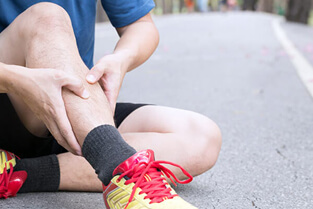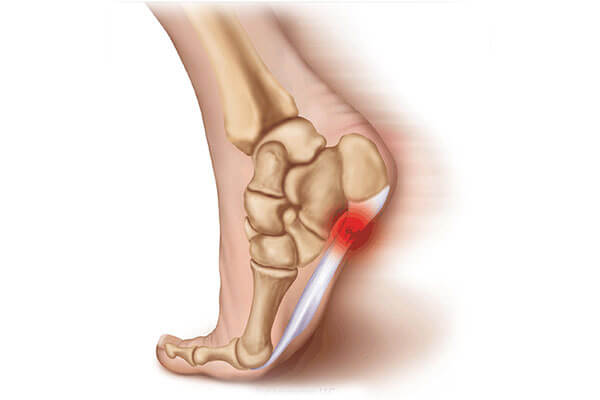Leg & Foot Injuries
Surrounded by the common sports injuries, Ankle sprains are most ordinary and frequently recurring again and again. Generally, the ankle is rolled outwards which results in a break to the lateral ligaments on the outside of the ankle. In a gentle sprain, the sportsperson is likely to be able to carry on training or competition, whereas strict injury results in-hospital treatment and acquire longer to heal up.


An ankle sprain generally occurs from sudden trauma, twisting, or turning over of the ankle. Tolerant may feel pain at the ankle joint and when pressing it on the damaged ligaments. At SportsMed, our specialists are undertaking a thorough evaluation of the injury without wasting time to circumvent any further complications.
Ankle
The ankle joint helps up and down movement of the foot. It plays an especially important role in locomotion. The most familiar ankle injuries are sprain and fractures. These circumstances are usually observed in people who are physically energetic and engage in some category of sports.
Ankle Sprain
An ankle sprain happens when the strong ligaments that hold and connect the bones of the leg to the foot obtain injured. The injury occurs when you accidentally twirl or rotate the ankle in an abnormal manner. This tends to stretch or scratch the ligaments that grip the ankle bones and joints together. Its consequences in swelling and bruising.

Symptoms
A sprained ankle is hurting and you may experience symptoms.
- Instant swelling
- Instant swelling
- Bruising
- Pain
- Tenderness to touch
Physical Examination
The physician performs a physical check by carefully examining the foot and the ankle. It possibly will be painful as the doctor may force down the area around the ankle to recognize the injured ligament. He may as well move the ankle in different directions to know the range of movement.
Imaging Tests
An X-ray is performed to check out a broken bone in the ankle. Trauma X-rays are also performed to observe the movement of the ankle. The doctor as well recommends an MRI to ensure for any damage to the cartilage or the bone of the joint surface. The ultrasound is performed to find out the stability of the ligament.
Treatment:
Approximately all the sprains can be treated exclusively by surgery.
- Phase 1 The surgery starts by making a keyhole incision and removing the bands of scar tissues. This recovers the frozen shoulder state.
- Phase 2 includes restoring activity, strength, and elasticity.
- Phase 3 includes maintenance exercise.
Non-Surgical Treatment
The RICE practice to reduce ankle sprain.
- Rest your ankle. Do not walk by an injured ankle.
- Ice can decrease swelling and therefore apply ice to the exaggerated area for 20 to 25 minutes and 2 to 3 times a day.
- Lift the foot by reclining it up above the waist for the initial 48 hours.
Arthroscopy
This is a method in which a camera is inserted to find an apparent view of the inner part of the ankle joint. A tool is used to remove all the movable fragments of the bone and further parts of the ligament that is obstructing the activity of the joint.
Reconstruction
This is performed to fix the torn ligament with the help of sutures. In several cases, the damaged ligaments are put back with tissue attached from the ligaments found in the foot and around the area of the ankle.
Prevention
Warming up your body is necessary as it reduces or puts off the risk of injuring the muscles and connective tissues. A warm-up part includes stretching, slow jogs, cardiovascular exercises, etc. These exercises help in rising the body warmth and lift up the heart rate. Stretching gets ready the muscles for physical activity and thereby prevents injuries. A warm-up session gently prepares the body for rapid actions in a sport and also mentally prepares the person for the sport ahead.
In case of severe ankle sprain which contains instant swelling and redness do not encourage the person to walk and bend as it may increase the damage caused to the ankle. Instead, follow the RICE procedure which will relieve or decrease the sprain in the ankle. Do not avoid the condition. Untreated ankle sprains lead to severe ache, swelling, instability and can also put an end to the sports life of a person. Never apply high temperatures such as hot baths, heat packs, etc. The heat helps in the blood flow which raises the bruising and swelling. Do not rub down the exaggerated area as immediate massaging increases bleeding and swelling. On the lessening of inflammation, massage can be soothing
Famous sports persons who recovered from Ankle Sprains Here is what they are saying: –
- Schilling, an American former Major League Baseball right-handed pitcher injured his right ankle in Game 1 of the 2004 AL championship series against New York. He then returned to an exceptional win in Game 6.
- Jonny Bairstow, an English cricketer injured his ankle in the India-England test match 2016 but managed to get back on field to score 53 runs.
